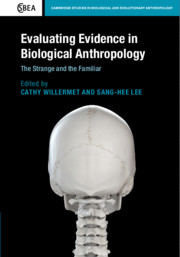Book contents
- Evaluating Evidence in Biological Anthropology
- Cambridge Studies in Biological and Evolutionary Anthropology
- Evaluating Evidence in Biological Anthropology
- Copyright page
- Contents
- Contributors
- Introduction
- Part I The Strange and the Familiar
- 1 Women in Human Evolution Redux
- 2 Hegemony and the Central Asian Paleolithic Record
- 3 Anthropology Now
- 4 The Strangeness of Not Eating Insects
- 5 Methods without Meaning
- Part II (Re)Discovery of Evidence
- Index
- References
5 - Methods without Meaning
Moving Beyond Body Counts in Research on Behavior and Health
from Part I - The Strange and the Familiar
Published online by Cambridge University Press: 01 November 2019
- Evaluating Evidence in Biological Anthropology
- Cambridge Studies in Biological and Evolutionary Anthropology
- Evaluating Evidence in Biological Anthropology
- Copyright page
- Contents
- Contributors
- Introduction
- Part I The Strange and the Familiar
- 1 Women in Human Evolution Redux
- 2 Hegemony and the Central Asian Paleolithic Record
- 3 Anthropology Now
- 4 The Strangeness of Not Eating Insects
- 5 Methods without Meaning
- Part II (Re)Discovery of Evidence
- Index
- References
Summary
Biological anthropology is an intentionally integrative discipline incorporating methods from various fields. As such, data collection techniques ranging from morphometric analyses of hominin fossils to assessments of human cardiac output via fitness trackers are being added to the methodological catalog. This reflects a trend toward an increased reliance on quantifiable data. These data enable researchers to identify ever more finite differences in individual physiologies, and to discover the threads that connect this variability to our evolutionary past. Thus, it is attractive in its appeal to seemingly more objective scientific approaches to our most enduring areas of inquiry. However, it also signals movement in the field away from a reliance on and confidence in qualitative and descriptive methods, and our unwillingness to ask experiential questions differently in evolutionary anthropological research than our peers in other biological sciences. Thus, these methodological innovations both enhance our findings and limit the plurality of the data that is valued in the field.
- Type
- Chapter
- Information
- Evaluating Evidence in Biological AnthropologyThe Strange and the Familiar, pp. 86 - 100Publisher: Cambridge University PressPrint publication year: 2019
References
- 2
- Cited by



